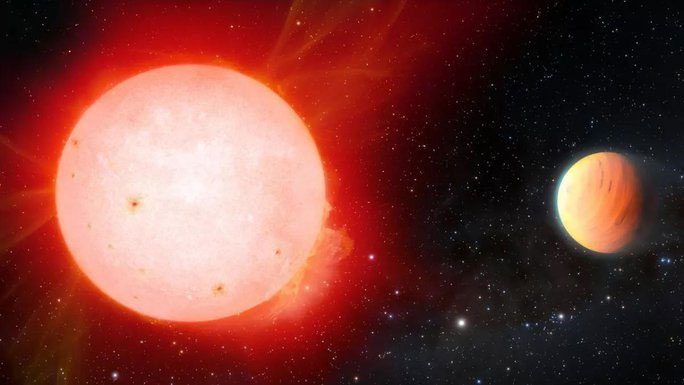Located 580 light-years away from Earth, a planet larger than Jupiter, soft like marshmallow candies, bathes in the reddish light from a red dwarf star.
The research led by planetary astronomer Shubham Kanodia from the Earth and Planetary Laboratory at the Carnegie Institution in Washington, D.C., has discovered the “sweet” planet named TOI-3757b from the vast data archive of NASA’s Transiting Exoplanet Survey Satellite (TESS).
According to Space, the “parent” of this planet is the red dwarf star TOI-3757, situated 580 light-years away in the constellation Eridanus. This makes TOI-3757b truly unique.

Graphic depiction of the marshmallow planet glowing with a pink-orange hue illuminated by a red dwarf star – (Image: NOIRLab/NSF/AURA)
According to Dr. Kanodia, giant planets are very difficult to form around red dwarf stars, and few have been observed at significant distances from their parent stars. This is the first gas giant planet observed around this type of star, even though red dwarfs are the most common type of star in the Milky Way galaxy, with a potential occurrence rate of up to 73%.
The reason for this is that red dwarfs, with their powerful radiation, can strip away the atmosphere of any gas giant nearby. Despite all odds, TOI-3757 exists, but of course, with some unique characteristics.
According to Science Alert, it is slightly larger than Jupiter—the largest planet in the Solar System—but has a very low mass, only about 85 times that of Earth. In comparison, Jupiter has a mass 318 times that of Earth.
The density of this planet is 0.27 grams per cubic centimeter. It is an extremely soft planet—so soft that it is unclear how it could have formed so close to its star: it takes only 3.43 days to complete an orbit around its parent star.
Dr. Kanodia and his colleagues suggest that there may be two factors contributing to its marshmallow-like lightness.
First, a massive gas cloud formed with a rocky core, around which gas accumulated to create a thick and expanding atmosphere. Because this red dwarf contains fewer heavy elements compared to other red dwarfs, the rocky core formed a bit more slowly, which delays the gas accumulation process and affects the density of the planet.
Second, the orbit appears to be slightly elliptical, meaning its distance from the star changes. Perhaps when it comes closer, the atmosphere heats up and expands.
The research team hopes to find more marshmallow-like worlds out there to help understand how they form and survive in places where they seemingly shouldn’t exist.
The study has just been published in the scientific journal The Astronomical Journal.


















































